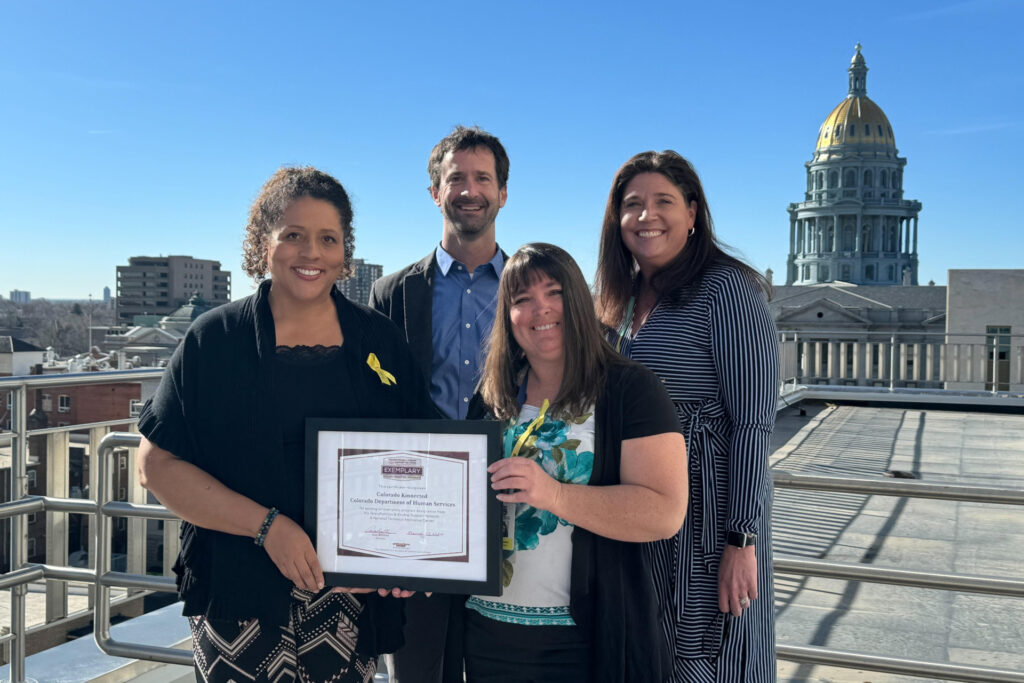Enhancing Practice with Families Impacted by Substance Use

The intersection of child maltreatment and parental substance use is a growing concern across the state of Colorado. Recently, The CDHS Division of Child Welfare has received a number of questions regarding how and when to administer drug testing when working with children, youth, and families.
We, at the CDHS Division of Child Welfare, encourage child welfare professionals to focus on behavioral change rather than compliance. To this end, we revisited guidance on proper considerations when determining appropriateness of testing for substance use in Drug Testing in Child Welfare: Practice and Policy Considerations published by the Substance Abuse and Mental Health Services Administration, summarized below, to aid county administrators and caseworkers grappling with this issue.
Substance use drug testing refers to the use of various biologic sources, such as urine, saliva, sweat, hair, breath, blood, and meconium to determine the presence of specific substances or their metabolites in an individual’s system. Drug tests, however, do not provide sufficient information for substantiating allegations of child abuse or neglect, or for making decisions about the disposition of a case. Drug testing is one tool that child welfare workers often use to determine if a parent is using substances and to facilitate decision making with families affected by substance use disorders.
However, limited information has been available to child welfare workers, judges and attorneys on the utility of drug testing and how to correctly interpret the results in the context of child welfare practice:
- A drug test alone cannot determine the existence or absence of a substance use disorder.
- Drug tests do not provide sufficient information for substantiating allegations of child abuse or neglect or for making decisions about the disposition of an assessment and/or case (including decisions regarding child removal, family reunification, or termination of parental rights).
- Child welfare workers, judges, and attorneys must make these decisions using information from the child abuse assessment, treatment plan progress, Colorado Family Safety and Risk Assessment tools and a comprehensive substance abuse assessment.
Best practice to identify a substance use disorder
The best way to identify a substance use disorder or determine if a child is negatively impacted is to use a combination of screening and assessment processes that include:
- the Colorado Safety and Risk Assessment tools,
- validated, research based clinical instruments,
- random drug testing,
- self-reports and
- observations of behavioral indicators.
Similar sources can also indicate attempts to change behavior and investment in the change process, as achieving sobriety is generally difficult for people with histories of continuous use.
Substance use testing and visitation
Assuming there are no other safety concerns, a positive drug test or a series of positive drug tests should not be used as a condition of child visitation, particularly for supervised visitation.
Positive drug tests are indications that treatment is not effective or that a more structured or intensive approach is needed. Visitation should not be taken away as a punitive response. Instead, team members should assess the adequacy of the treatment plan for continued use as a part of the response. Visitation is critical in maintaining the parent child bond and should be maintained whenever possible. It is helpful for practitioners and policymakers to establish partnerships with their local substance abuse treatment counterparts, who can assist in the decision making critical to successful development and implementation of drug testing policies.
Hair follicle testing on children
Having a stranger cut a swatch of a child’s hair can be a traumatic experience for children. Very little information is gained from such tests and does not justify the trauma that may be caused to children. Information about the substance use of a caregiver may be gained in multiple other ways. In addition, positive hair follicle tests can raise a number of questions. Hair follicle testing does not determine when the exposure took place or if there is a safety concern for a child. There is little information contained in the literature regarding child welfare practice related to the practice of hair follicle testing on children. Information exists regarding the use of hair follicle testing as a form of drug screening in parents, however some disadvantages are identified with this. The hair follicle test requires that a swatch of hair (90 – 120 strands of hair) be cut as close to the scalp as possible in order to detect metabolites of common drugs. Metabolites of drugs are found in the hair shaft if the person has ingested the drugs more than 1 – 7 days prior to the test. The drug itself may be found in the hair shaft if the exposure is environmental rather than through use (Labcorp).
Disadvantages include the test’s inability to detect single-drug use within the last 1-7 days (Office of National Drug Control Policy, p. 9). Hair specimen testing is not effective for monitoring compliance on a regular basis because it cannot discriminate between recent drug use and use that occurred months earlier. Differences in hair structure, porosity, use of hair-color products, and external contamination can affect drug test results. (SAMHSA p.8)
This link connects to a list of national and state resources regarding the use of drug testing in child welfare. Funding for substance use testing
Core Services Program funds cannot pay for substance use testing when the testing is not directly tied to substance use treatment and a substance use treatment plan.
Additional training, sources & resources
If you are looking for more information and guidance, we encourage you to check out Enhancing Practice with Families Impacted by Substance Use. This interactive two-day training, suitable for new caseworkers, experienced caseworkers, and supervisors alike, offers advanced skill building. Teams or units are also invited to attend together. Bring real-life case examples with you! We’ll combine instruction with an emphasis on sharing successes and overcoming challenges through practical experiences.
You’ll leave armed with additional tools to enhance your safety-building practices and aid in decision making, managing safety, engaging families, identifying protective capacities, and making placement and permanency decisions. You’ll also enhance your skills in collaborating with professional partners throughout the child welfare system. Come prepared to be challenged and expect to leave with new insights.
Please visit www.coloradocwts.com >Find A Class> In-service Classes > Enhancing Practice with Families Impacted by Substance Use >and register today!
National Center on Substance Abuse and Child Welfare – Drug Testing in Child Welfare
Drug Testing in Child Welfare: Practice and Policy Considerations (PDF 92 KB)
Substance Abuse and Mental Health Services Administration. 2010\



